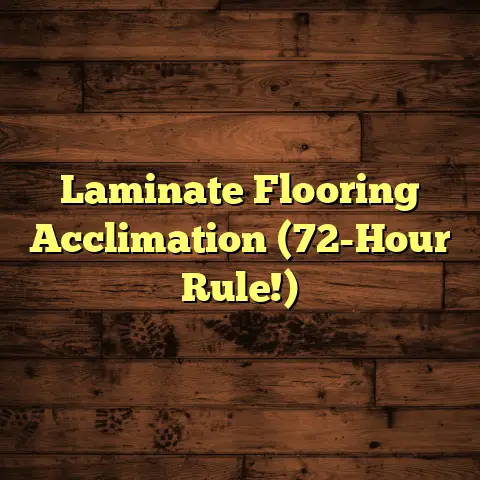Effective Methods For Preventing Mold Growth? (Explained)
Mold is more than just an eyesore; it can seriously impact our health. I’ve seen firsthand how mold growth can cause respiratory issues, allergies, and even more severe health problems. For anyone who has ever dealt with mold in their home, you know the frustration it brings. I’ve spent years in the flooring industry, and I’ve learned that prevention is key. Let’s explore effective methods for preventing mold growth.
Understanding Mold and Its Causes
Mold thrives in damp, dark environments. It can grow rapidly in areas with high humidity or where water has accumulated. Common locations include bathrooms, basements, and areas around leaky pipes.
I remember a project where I installed hardwood floors in a bathroom. The clients had noticed some mold on the existing tiles due to a minor leak. After addressing the leak, we discussed prevention during the installation of the new flooring.
The Role of Humidity
Humidity is a mold’s best friend. Keeping indoor humidity levels below 50% can significantly reduce the chances of mold growth. I often recommend using a dehumidifier, especially in areas prone to moisture.
In one job at a coastal home, the humidity was consistently high. We installed a dehumidifier in the basement, which helped maintain optimal humidity levels. It not only kept the space comfortable but also protected the flooring from potential mold growth.
Regular Maintenance
Regular maintenance is essential for preventing mold. I’ve learned that small tasks can go a long way in keeping your home mold-free.
Inspect for Leaks
Regularly checking for leaks in pipes, roofs, and windows is crucial. During one of my projects, I discovered a leak under the kitchen sink that had gone unnoticed for months. By addressing this issue early, we prevented further damage and possible mold growth.
Cleaning and Ventilation
Good ventilation is critical. I always advise my clients to use exhaust fans in bathrooms and kitchens to help reduce moisture levels. In one instance, a homeowner didn’t have an exhaust fan installed. After a few months of cooking and showering, mold started to creep into the corners of their walls.
Regular Cleaning
Cleaning regularly can help keep mold at bay. I recommend using vinegar or baking soda as natural cleaning agents. They are effective against mold and mildew without harsh chemicals.
During another project, I shared this tip with clients who had young children, ensuring they could keep their home safe and clean without worrying about harmful substances.
Flooring Choices Matter
The type of flooring you choose can influence mold growth as well. Certain materials are more resistant to moisture than others.
Water-Resistant Options
When installing flooring in moisture-prone areas, consider water-resistant options like tile or vinyl. I’ve worked on projects where homeowners opted for laminate flooring in bathrooms, only to face mold issues later on due to its susceptibility to water damage.
In contrast, choosing tiles for those same spaces not only enhanced the aesthetic but also provided a durable barrier against moisture.
Effective Insulation
Proper insulation can prevent condensation, which leads to mold growth. Insulating attics and crawl spaces helps maintain temperature control and reduces moisture buildup.
I once had a client who faced significant mold issues in their attic due to inadequate insulation. After improving the insulation, they noticed a marked difference in humidity levels throughout the house.
Using Mold-Resistant Products
Utilizing mold-resistant materials during construction or renovation can make a significant impact.
Mold-Resistant Drywall and Paint
I always recommend using mold-resistant drywall and paint in areas prone to moisture. These products contain additives that inhibit mold growth, providing an extra layer of protection.
In one project, we used mold-resistant drywall in a basement renovation, which helped prevent future mold issues despite the home’s high humidity levels.
Monitoring Indoor Air Quality
Maintaining good indoor air quality is essential for preventing mold growth. I suggest using air purifiers with HEPA filters to trap airborne spores and allergens effectively.
During a recent job, a family requested an air quality assessment after experiencing allergic reactions. Installing an air purifier helped improve their indoor air quality, contributing to a healthier living environment.
Cost Considerations
When it comes to flooring installations and maintenance, cost estimation plays a crucial role. In my experience, using tools like FloorTally has simplified the budgeting process significantly.
Accurate Budgeting with FloorTally
With FloorTally, I can quickly pull accurate material and labor costs tailored to local rates. For instance, while estimating costs for installing tile flooring in a bathroom, FloorTally helped me provide my clients with transparent pricing right from the start.
This not only built trust but also ensured my clients were fully aware of potential expenses related to moisture barriers or additional cleaning products necessary to prevent mold.
Creating a Mold Prevention Plan
Establishing a comprehensive mold prevention plan is essential for long-term success.
Step-by-Step Approach
- Assess Vulnerable Areas: Identify locations in your home that are prone to moisture.
- Implement Humidity Control: Use dehumidifiers and ensure good ventilation.
- Regular Inspections: Check for leaks and signs of moisture regularly.
- Select Appropriate Materials: Choose water-resistant flooring and mold-resistant products.
- Maintain Indoor Air Quality: Use air purifiers and monitor humidity levels.
Advanced Techniques for Mold Prevention
Beyond basic practices, there are advanced techniques that can further help in preventing mold growth.
Install Vapor Barriers
In areas like basements or crawl spaces where moisture tends to accumulate, installing vapor barriers can be highly effective. These barriers prevent moisture from seeping through walls or floors from the ground below.
I recall a job where we renovated a basement that experienced frequent dampness. By adding a vapor barrier under the new flooring, we significantly reduced moisture levels and created a healthier environment.
Use High-Efficiency HVAC Systems
Investing in a high-efficiency HVAC system can help control humidity levels throughout your home. These systems often come equipped with built-in humidity control features that adjust airflow based on humidity levels.
In one instance, I worked with clients who upgraded their HVAC system specifically for this reason. They reported improved comfort levels and no signs of mold growth even during humid summer months.
Employ Smart Home Technology
Smart home technology has made it easier than ever to monitor and control indoor environments. Devices that measure humidity levels can alert you when conditions become favorable for mold growth.
I recently installed smart sensors in a client’s home that sent notifications when humidity levels exceeded 50%. This proactive approach allowed them to address issues before they escalated.
Personal Experiences with Mold Prevention Techniques
Over the years, I’ve encountered numerous challenges regarding mold prevention and learned valuable lessons along the way.
The Unexpected Leak
In one case, I took on a renovation project in an older home where the owners had been experiencing recurring mold issues in their basement. Upon inspection, we discovered that an old pipe had been leaking for years behind the walls—something they weren’t aware of until we started tearing down drywall.
Dealing with this unexpected leak added time and cost to our project but allowed us to address the root cause of their mold problem effectively. We replaced the pipe and used mold-resistant materials during the remodel.
The Importance of Communication
Another significant lesson I’ve learned is how vital communication is with homeowners regarding maintenance practices post-installation. After completing a flooring project, I make it a point to educate clients on how to maintain their new floors properly and avoid mold growth.
On one occasion, I installed laminate flooring in a family’s kitchen but neglected to emphasize the importance of drying spills promptly. A few weeks later, they called me about noticing some discoloration on the edges of their new flooring—an indication of early mold growth due to excess moisture.
Now, I always include maintenance tips as part of my final walkthrough with clients!
Success Stories: Mold-Free Homes
Despite challenges, I’ve also witnessed incredible success stories through diligent efforts in preventing mold growth.
A Transformative Basement Renovation
One of my favorite projects involved transforming a damp basement into a usable living space for a family. We started by addressing moisture issues with proper drainage solutions outside the home and installing vapor barriers inside.
After completing the renovation with water-resistant flooring and adequate ventilation systems, the family was thrilled with their new space! They reported no signs of moisture or mold since our work was completed several years ago.
Turning Around an Old Commercial Space
In another instance, I worked on converting an old commercial space into apartments when we discovered significant mold behind walls due to years of neglect. Instead of shying away from this challenge, we tackled it head-on by removing contaminated materials and treating affected areas with antimicrobial solutions.
The result? A beautiful apartment complex that has maintained its integrity without any reports of mold infestation since our renovations!
Building Long-Term Relationships
As someone who has spent countless hours working in homes across different communities, I’ve developed long-term relationships with many clients who trust my expertise regarding mold prevention—and for good reason!
Follow-Up Visits
I often schedule follow-up visits after completing projects to ensure everything remains up to standard and address any concerns my clients may have about maintenance practices or potential issues they might encounter down the line.
During one follow-up visit at a client’s newly renovated bathroom space (which included tiles designed specifically for wet environments), they expressed appreciation for my ongoing support! They shared how implementing some of my recommendations regarding cleaning products helped maintain their bathroom’s freshness without introducing harmful chemicals into their home environment.
Cost-Effective Solutions for Mold Prevention
When discussing effective methods for preventing mold growth, it’s essential not only to focus on high-end solutions but also to consider cost-effective options that still yield positive results.
DIY Solutions
Many DIY solutions can effectively combat molds without breaking the bank! For example:
- Vinegar: A solution made from equal parts water and vinegar can effectively kill many types of mold when sprayed directly onto affected areas.
- Baking Soda: Mixing baking soda with water creates a paste that can scrub away light stains while also absorbing odors.
- Tea Tree Oil: While slightly more expensive than vinegar or baking soda, tea tree oil is an all-natural antifungal agent that works wonders against molds when diluted appropriately with water.
I’ve shared these DIY solutions with clients looking for budget-friendly alternatives after installation projects!
Government Assistance Programs
For homeowners struggling financially yet seeking assistance maintaining healthy living conditions free from molds—many local governments offer financial aid or grants aimed specifically at improving housing quality standards!
I came across information about such programs while researching resources available when working on community projects focused on home revitalization efforts aimed at reducing health hazards associated with poor housing conditions—such as excessive moisture leading directly towards increased instances of molds developing indoors!
Conclusion: Your Path to Mold-Free Living
Preventing mold growth requires consistent effort and vigilance. By understanding the causes of mold and implementing these effective methods, you can protect your home and health.
Reflecting on my experiences as a flooring contractor, I’ve seen the positive impact these practices can have on homes. Whether it’s selecting the right flooring materials or ensuring proper ventilation, each step plays a crucial role in creating a healthier living environment.
By sharing my insights and anecdotes, I hope you feel empowered to take actionable steps toward preventing mold growth in your home. What strategies have you found effective? Have you faced challenges in your efforts? Let’s keep the conversation going about creating safe, beautiful spaces!





